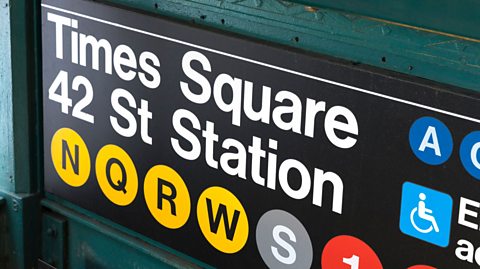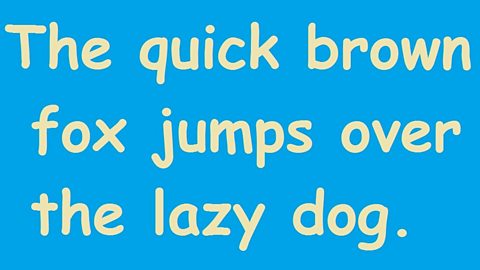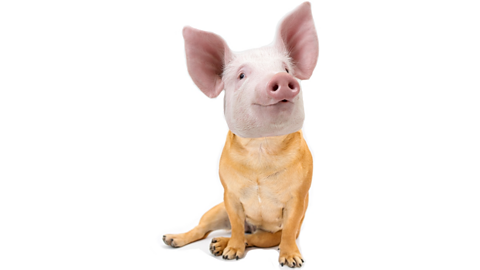A popular typeface rarely happens by accident. In fact, there’s often a tale it could use itself to write.
Take the one you‚Äôre reading right now, for example. It‚Äôs called Reith and was introduced by the ≥…»ÀøÏ ÷ in 2018. Chosen, among other reasons, to be as readable as possible across all devices in an increasingly digital world, its name comes from John Reith, the organisation‚Äôs first director general.
There are plenty of other stories to be told about the typefaces we encounter in everyday life, including Gill Sans, the one Reith replaced as the public-facing written word of the ≥…»ÀøÏ ÷. You can learn all about that, and a few other notable designs which helped make history, below; including why we‚Äôre talking about typefaces, and not fonts.
Gotham
It takes more than a typeface to put a president in the White House, but what is true is how prolific this simple graphic style with its own sense of heft was in Barack Obama’s 2008 election campaign. From its first use in the early caucuses, Gotham maintained a continuity which ran right through to election day itself.

The sans serif design (translated as 'without lines', sans serif typefaces have no protruding tails or strokes on any of the letters) appeared on thousands of placards waved at rallies across the US.
That was a big achievement for such a new typeface, one which was only created eight years earlier. Creators Jonathan Hoefler and Tobias Frere-Jones were commissioned by men’s lifestyle magazine GQ to build a typeface which would complement the brand. The New York-raised designers looked around their home city for inspiration and, independently of each other, spotted the straightforward, boxy lettering in the sign of a bus terminal building on 42nd Street. Independently, lightning struck.
Tobias explained in a 2007 documentary film how the lettering was: “Not the kind of letter that a type designer would make, it’s the kind of letter that an engineer would make.”
The seed for the Gotham typeface had been planted. GQ adopted it as planned and in the months before the 2008 election, Barack Obama featured on the cover, surrounded by blurbs presented in a typeface synonymous with both candidate and magazine.
Helvetica
We encounter Helvetica every day, even if we don’t realise it. This Swiss-made typeface has been prolific since its 1957 creation, becoming the written voice of reliable information and trustworthy directions.
Your passage through a network of hospital corridors is often guided by signs written in Helvetica. The same goes for airports. Helvetica spells out the name of the United States on the side of space shuttles and it was once used on the website, providing official advice for any citizen who requested it.

On Helvetica’s 50th anniversary, Frank Wildenberg, managing director of the German firm which owns the typeface, : “It's durable. It comes from natural design forms. It doesn't have an expression of fashion. It has very clear lines and characters, it looks like a very serious typeface.”
However, the reliable lines and curves of Helvetica have led to criticism, with some decrying Helvetica as being too safe and dated a choice for the 21st Century.
One person who wouldn’t agree is Helvetica fan Lars Mueller, who wrote an entire book on the typeface. He described it as having a modern attitude in keeping with the aesthetics of the era it was created. As something which could appear on a kebab shop sign as much as it would a high street bank, Mueller has even called it "the butter on the bread."
Times New Roman
It’s a feather in the cap for The Times newspaper that one of the most widely-used typefaces in existence was created for and named after their publication.
Ninety years ago, designer Stanley Morison was approached by the newspaper’s management to create a new typeface. It would have to be larger than the type in use, but not take up any more space; be readable and still appear heavier than its predecessor.
What sounds like a knot of contradictions to the casual reader became a challenge to Morison. His main source of inspiration was the old-style typeface Plantin, named after the 16-Century printer Christophe Plantin. Working alongside designer Victor Lardent, it took Morison two years to finesse Times New Roman into the typeface which finally landed on the newsstands in 1932.
The new look even merited an article in its own right, which described the shift in type as: “one of the biggest undertakings ever accomplished in a newspaper office.”
Times New Roman remained the newspaper’s standard into the 1970s. Although it no longer creates headlines, it remains a bedrock option in word processor packages around the world.
Johnston Sans & Gill Sans
In 1916, calligrapher Edward Johnston was approached by the team at London Underground to create an umbrella typeface which would be used across all its posters and signs. There was good reason for this. Not only would it please the eye, but with so many different rail companies using the tunnel network at that time, bringing every piece of information under one umbrella design was thought to be less confusing for customers.
What they perhaps didn’t count on was Mr Johnston creating a sans-serif typeface that remains in use more than 100 years later.

Donna Steel, curator of a 2016 exhibition of the designer and his work, said in a ≥…»ÀøÏ ÷ interview: ‚ÄúJohnston Sans combined readableness, beauty, simplicity. It's reassuring, which is so important when we're travelling, because when we're travelling we're vulnerable. With Johnston, the typeface is confident and it reassures us. We know when we've got the right place and his message is clear.‚Äù
Twelve years after Johnston Sans became one of London‚Äôs most recognisable typefaces, its designer‚Äôs pupil, Eric Gill, took the concept and developed it into another utilitarian-looking collection, Gill Sans. It became just as prolific as its inspiration, used on the covers of Penguin books and to continue the train theme, British Railways posters and leaflets. Gill Sans is still in use today. Scroll back to the top of this page for a moment and you‚Äôll see some capital examples in the ≥…»ÀøÏ ÷ logo.
Comic Sans
It may not be everybody’s favourite font but Comic Sans was definitely created with the best of intentions.
Vincent Connare was a typographer for Microsoft in the early 1990s when he noticed that one of its programs aimed at children needed a little help. Called Microsoft Bob, it involved a talking dog addressing the user via speech bubbles. But when Times New Roman was used as the typeface for the dog’s messages, Vincent spotted the potential for a different look to his words. As he said in a 2017 Guardian interview: “Dogs don’ talk in Times New Roman!”

Using graphic novels such as Watchmen for a guide, Vincent developed his own typeface which mirrored those used to convey the action in comic books. Deliberately made to look wonky and avoiding straight lines where he could, he came up with Comic Sans - but on completion it was too late to be used in the Microsoft Bob program. Instead it became rather popular around the Microsoft offices in emails with an intended smiley tone. Its use was so prolific, it found its way into Windows 95 where users could also write cheerful Comic Sans messages to their pals.
And although entire websites have been set up to give Vincent’s brainchild a good bashing, it’s perhaps worth remembering that the simple style of Comic Sans does make it one of the recommended typefaces by the British Dyslexia Association (as are others including Arial, Verdana and Century Gothic).
With serifs making it more difficult for people with dyslexia to scan words, their official advice for schools and families is: “Use sans serif fonts, such as Arial and Comic Sans, as letters can appear less crowded.”
You may have been wondering why this exploration of historic typefaces rarely used the word font. That's because a font and a typeface are seen in some quarters as two very different things and some experts in the field don't like to confuse the two.
A typeface? That's a family of fonts. The point size, the width and the style, they're the fonts of a typeface, but the prolific use of the former in computer packages has seen a blur of meaning between the two words in the past 25 years.
So when you think of a typeface, imagine a designer hunched over the drawing board for months, even years, sweating asterisks over type that could inform an entire era.
What do the words we use say about us?
Find out more about the words we use and what they say about us in this guide.

Eight words or phrases we need in English
Ever wanted to know what your innerer schweinehund is? Look no further.

Five words that have changed their meaning
Why we used to call serious people 'silly' - and other language curiosities.
